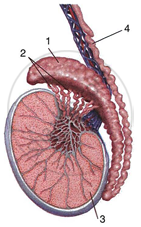Advertisements
Advertisements
प्रश्न
Answer the following question based on the human male reproductive system:
What is the length of a sperm?
उत्तर
A sperm is approximately 60 micrometres long.
APPEARS IN
संबंधित प्रश्न
Humans reproduce ____________.
Differentiate between Rod cells and cone cells (pigment)
Multiple choice question. Tick (✓) the correct choice:
Testis are present in a sac called
- scrotum
- oviduct
- epididymis
- none of the above
Describe the functions of the following:
Oviduct
The diagram shown below is the lateral section of the testis of man. Study it carefully and answer the questions that follow:

(i) Label the part I to 4 of the diagram.
(ii) State the functions of the parts labeled 1 and 2.
State the Location:
Seminal vesicle
State the Location:
Cowper’s glands
In humans, sperm production occurs in the organ ______.
In the male reproductive system, the vasa deferens joins the ____________.
The ejaculatory ducts open into the ______.
Each testis is connected to the wall of scrotum by short. fibromuscular band called ______.
Seminal plasma, the fluid part of semen is formed by ______.
In human males, the testes lie in the scrotum, because it helps in the ______
What is the length of the sperm?
Given below is a certain situation. Analyze and describe its possible impact on a person:
Prostate and seminal vesicles are not functional.
Draw a labelled diagram of male reproductive system.
Name the following:
Three accessory glands of human male reproductive system.
The packing tissues between the coils of the seminiferous tubules are called as ______.
Given below is a group of terms. In the group, one pair indicates the relationship between the two terms. Rewrite and complete the second pair on a similar basis.
Follicle cells : Ova :: ______ : Sperms.
The figure given below is an important gonad of humans. Study the figure and answer the following questions.
 |
- Identify the organ. Write its specific location in the body.
- Label the parts shown in the figure as 1 to 4.
- Write important functions of parts 2 and 4.
- Name one cellular structure and one hormone which are produced in part 3.
- Draw a neat and labelled diagram of the cellular structure mentioned by you in (d).
